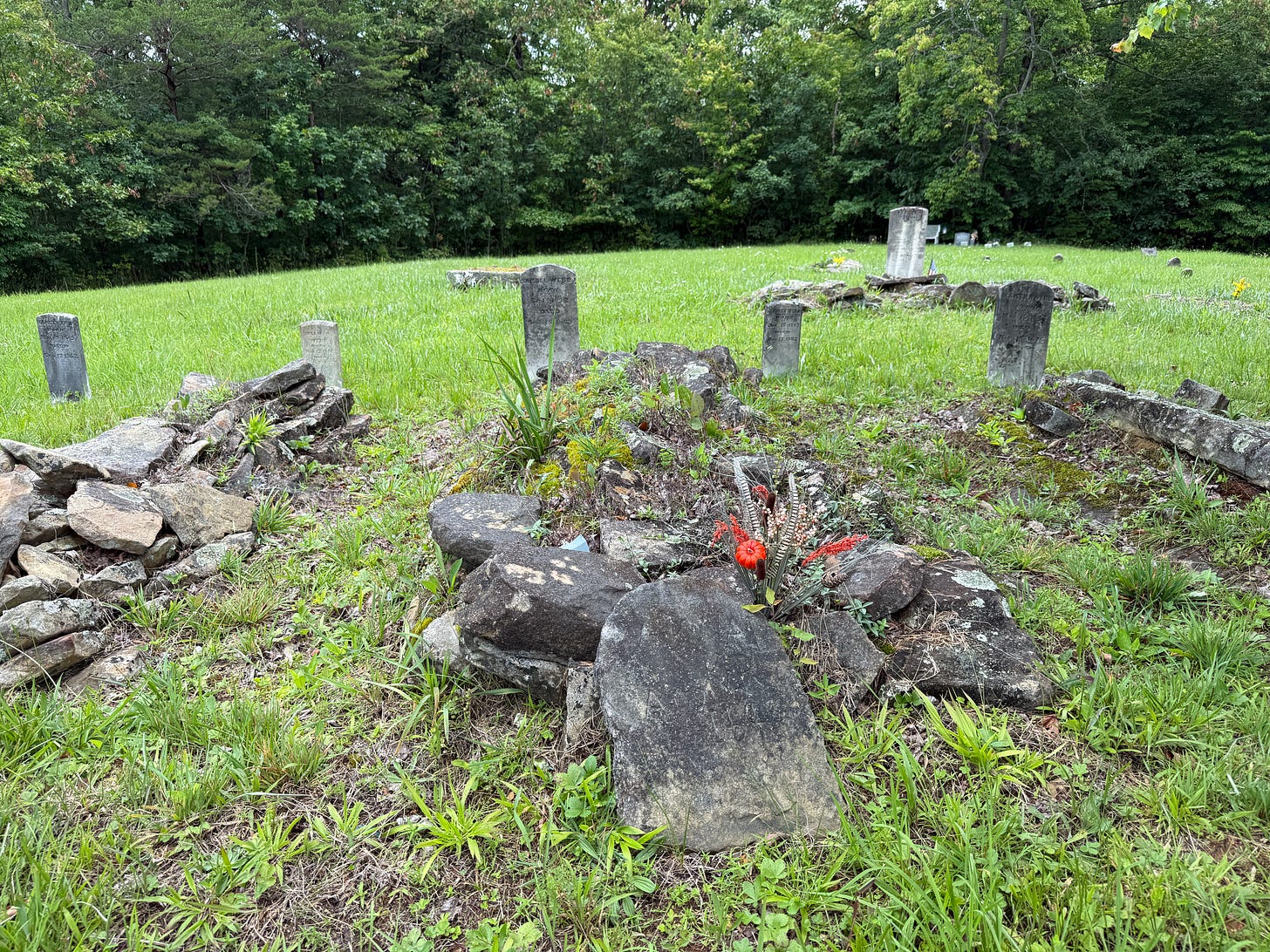Sunday Drive: The scenic backroads connecting Scott and Morgan counties
Plus: The 'Sacred Ground' series visits Carpenter Cemetery
You’re reading Friday Features, a weekly newsletter containing the Independent Herald’s feature stories — that is, stories that aren’t necessarily straight news but that provide an insightful look at our community and its people. If you’d like to adjust your subscription to include (or exclude) any of our newsletters, do so here. If you haven’t subscribed, please consider doing so!
Today’s newsletter is sponsored by First National Bank. Since 1904, First National Bank has been a part of Scott County. First National is local people — just like you. Visit fnboneida.com or call (423) 569-8586.
A drive through the scenic farmland of southern Scott County
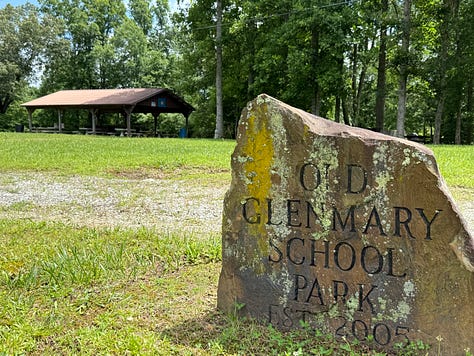
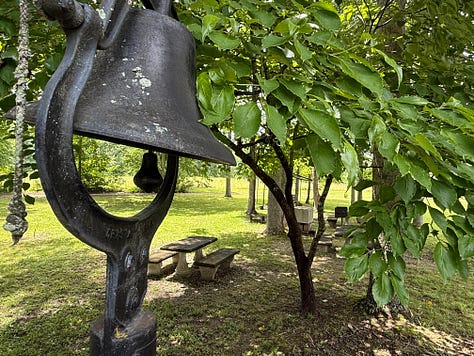
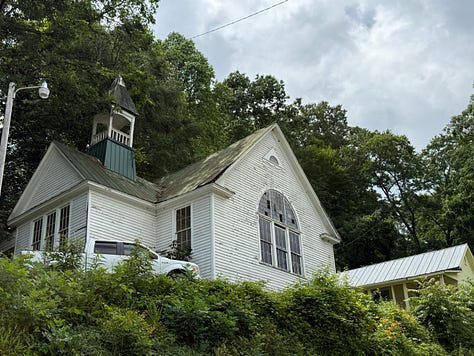

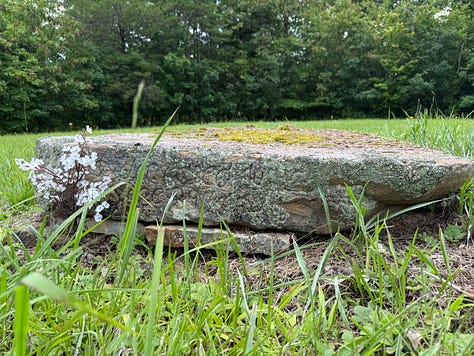
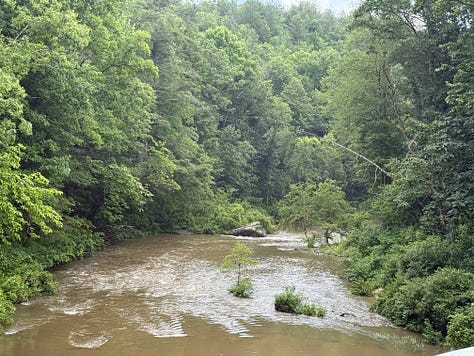
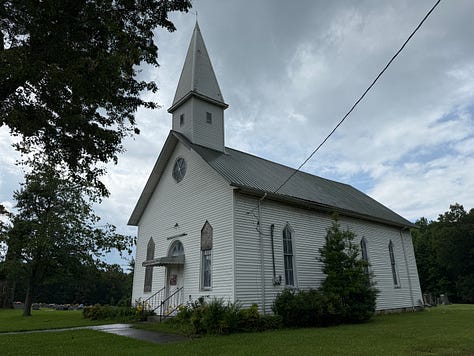
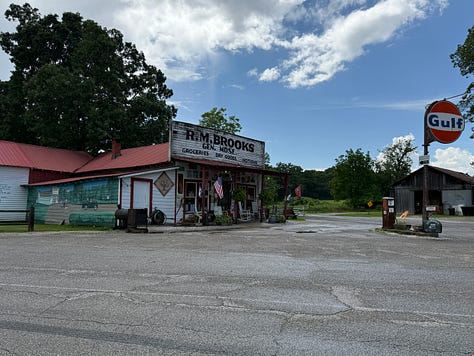
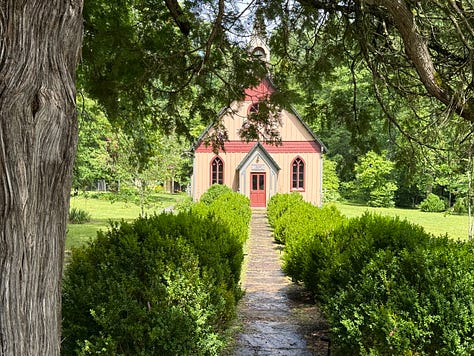
This week’s Sunday Drive is a bit shorter than the first three, as we head through the scenic southern part of Scott County and northern Morgan County: through Nydeck to Brewstertown and then into Historic Rugby.
Our first three road trips — up Rock Creek and across Parkers Mountain, over S.R. 116 and down New River, and across Capachene and down Jellico Creek — all involved travel on gravel roads. This one, however, is paved all the way, making it perfect for motorcycles and the brand-new family sedan. In fact, this route is quite fun on two wheels … or three, if that’s your preference.
Most of us who didn’t grow up in the Nydeck, Burrville and Brewstertown areas seldom venture there. The main highways don’t go through those communities, skirting them via U.S. Highway 27 north and south, and S.R. 52 east and west. There are no retail targets in these neighborhoods, and so there’s no reason to drive through unless you live there or have family there. But this is quite a scenic area, and well worth a quick Sunday afternoon drive into the countryside. So, buckle up, and let’s get started.
To Glenmary: Assuming a starting and stopping point at the U.S. 27/SR. 63 intersection in Huntsville, this road trip is only 52 miles, requiring less than 90 minutes to complete without stops. We’re first going to head south on U.S. Highway 27 to Glenmary, once one of Scott County’s most happening places, to a community park that a majority of Scott Countians have no idea exists.
It's about 10 miles south on U.S. 27 from the 27/63 intersection to Glenmary Missionary Baptist Church. Glenmary was once a busy depot on the Cincinnati-Southern Railroad (which we know today as the Norfolk-Southern Railroad). It was a major shipping point for coal, due to mining operations in the Coal Hill area east of the tracks. The Glenmary Coal & Coke Co. was a major operation in the late 1800s and early 1900s. But we don’t want to get too far ahead in the story; we’ll be returning here on a future road trip.
For today, we have a specific destination in mind: the site of the old Glenmary School, which sits on the hill above the community’s Baptist church. The school is no longer there, but Glenmary School Community Park — which was established in 2005 — is, though most Scott Countians have never been there.
Turn right at the Glenmary Missionary Baptist Church and take the paved one-lane road (which is Glenmary Road) to the top of the hill. At the top of the hill, turn onto Old Glenmary School Road, a gravel lane, to enter the park.
The five-acre park is on property owned by Roger Russell and Dale Webb. It is well-maintained, with a picnic shelter, picnic tables and a few pieces of playground equipment. It is almost surprising to find it here if you aren’t familiar with the area. Most Scott Countians are well acquainted with Oneida City Park, and probably the municipal parks in Huntsville and Winfield, as well as the county-owned John John Yancey Memorial Park in Huntsville and perhaps even the Robbins Community Park. But this is a facility that most aren’t familiar with. It’s a peaceful spot to enjoy a picnic lunch as the drive begins. And don’t worry about the weather; most of the picnic tables are covered.
The name of one of the owners — Webb — goes all the way back to the beginning of Glenmary. The Webb family was one of the first on the scene in Glenmary, even before the first coal mine opened in 1878. Prior to the railroad in 1880, this area was known as Redman or Black Wolf Creek. The Redman family owned the farm that later became the Kline farm on Nydeck Road. Glenmary was also once known as Glen Hazard.
It wasn’t just the coal mines that brought people to Glenmary. The Tennessee Coal & Lumber Co. was a major industrial player here, too. In fact, before the Oneida & Western Railroad was built, the original plans were to build a railroad from Glenmary to Jamestown.
It was in 1922 that the Glenmary School was built on this ridgetop above the town. It was used until the 1960s. On the other side of Glenmary Road from the park is Red Hill — also owned today by the Russell family — where the Tennessee Coal & Lumber Co.’s company houses were once built.
Upon leaving the park, we’ll return to U.S. 27 the same way we came up, via Glenmary Road. As you drive back down the hill, take note of the two churches, one on either side of the road. Neither is in use today, but the white church on the hill was once the Glenmary Presbyterian Church, and the red church by the highway was the Glenmary Missionary Baptist Church. The Presbyterian Church was built in 1907, and became the Glenmary Congregational Church in 1929. The Baptist church was built in 1944 on land owned at the time by Gatewood Pemberton. The first pastor was Dewey Thomas.
Just south of the two churches, directly on the highway, is a two-story brick building that was built by George Watts in 1931. The first floor was used as a store and post office, while the upper floor was living space for the Watts family. Together, these three buildings, the old post office and the churches, are about all that remains of old Glenmary.
To Nydeck: Back at U.S. 27, we’ll turn left to head north, as if we’re returning to Huntsville. We aren’t. Instead, we’ll quickly turn left onto Nydeck Road, the first road to the north of Glenmary Road. This was once the main route from Jamestown to Glenmary, and if it had ever been built, the railroad from Glenmary to Jamestown would have closely followed this route. It wasn’t always known as Nydeck; it was originally called the Glenmary to Sunbright Road.
Today, Nydeck Road is a two-lane, striped road that travels through some of the largest expanses of farmland left in Scott County. One of the very first farmers here was a War of 1812 veteran named Andrew Leutian Lewallen, who fought with Gen. Andrew Jackson at the Battle of New Orleans. His brother, John Lewallen, was the first sheriff of Scott County. His parents, Anderson Grant Lewallen and Sally Rice, lived in the Campground area beyond Coal Hill.
The farmland at the beginning of Nydeck Road has been in the Kline family since it was purchased by Dr. George Kline. Before that, this was Pemberton country. Grover Pemberton owned the farm after his father, Gatewood Pemberton, owned it. The Pemberton Cemetery is located on the northwestern corner of the farm. Prior to the Pemberton family, this was the Redman farm from which the community took its name.
Beyond the Kline farm, Nydeck enters a hemlock forest where Black Wolf Creek empties into White Oak Creek. This is the same White Oak Creek that eventually skirts Rugby on its way to the Clear Fork River. It is, in fact, the Clear Fork’s largest tributary.
After exiting the creekside forest, Nydeck continues through another residential area, crossing from Scott County into Morgan County. A short distance into Morgan County is the Carpenter Cemetery, where Andrew Leutian Lewallen is buried. It is one of the most unique cemeteries in this area. Dating back to the 1840s, it contains several graves that have rocks stacked on them in a method unusual for cemeteries in this region.
To Burrville: About 5.7 miles after turning off U.S. 27, Nydeck Road intersects with Brewstertown Road. If we turned right, we’d emerge at Rugby. But we want to head on into the Big South Fork National River & Recreation Area, so we’ll stay left and continue toward Burrville. A note about Brewstertown: this entire area southwest of Rugby was named after the Brewster family that was once prominent here. The family dates back to John W. Brewster (1823-1911), a Baptist minister who once lived here. He’s buried at Carpenter Cemetery, along with Andrew Leutian Lewallen.
In another 2.5 miles, Brewstertown Road intersects with Burrville Road. Turning left here would take you to Sunbright High School. We’re going to turn right instead, driving through the tiny community of Burrville.
Like Glenmary, there isn’t much left of Burrville today. One exception is the Mt. Vernon Methodist Church, although it’s known only as Mt. Vernon Church now. The church was founded in 1850. The cemetery that neighbors it, the Mt. Vernon Cemetery, is the largest cemetery in this area, containing more than 500 graves. It also dates back to about 1850, and if you walked through it you would discover the graves of many of this area’s early residents — especially the Peters family (more on them in a moment).
Burrville was originally known as Mt. Vernon beginning in about 1830. However, when the post office was established in 1881, it was named Burrville — due to the fact that there was already a Mt. Vernon in Blount County, Tenn. A fun fact: the town of Clinton, Tenn. was originally named Burrville in 1801, for Vice President Aaron Burr, but the name was changed after Burr was disgraced by killing Alexander Hamilton in a duel in 1804.
To Peters Ford: At the intersection with Glades Road that heads south towards Deer Lodge, the road we’re traveling becomes Peters Ford Road. At the intersection of Peters Ford Road and Glades Road is the Burrville Grocery & Deli. This intersection is about three miles beyond where we turned right onto Burrville Road, and a little more than half a mile beyond the Mt. Vernon Church.
Three miles beyond the Burrville Grocery & Deli, the highway descends to Clear Fork and crosses Peters Ford. This old ford in the river was named for the Peters Family that was prominent here. Many of them are buried at the Mt. Vernon Cemetery.
Perhaps the most famous of the Peters family was Absalom “Barton” Peters (1871-1923). He’s buried at Mt. Vernon, and was founder of the Morgan County News newspaper. He was the Morgan County Schools superintendent when he died at age 51.
The Peters family in this area dates back to James Peters (1798-1874), who moved in from the Oak Ridge area. Like many other members of his family, he’s buried at Mt. Vernon.
Peters Ford is located where Crooked Creek empties into the Clear Fork River. Crooked Creek drains most of the land around Allardt. Big Branch, which flows through the Colditz Cove State Natural Area, empties into Crooked Creek. The Clear Fork River, meanwhile, heads up in the Banner Springs area south of Allardt.
Peters Ford is the southernmost edge of the Big South Fork National River & Recreation Area, which encompasses 125,000 acres and is the fifth-largest National Park Service unit in the eastern U.S.
To Rugby: Beyond Peters Ford, the highway climbs back to the top of the plateau, through more farmland, and emerges at S.R. 52 at Pleasant View Church.
We’re taking a right to head back towards Scott County. Some 7.4 miles along the highway, the road crosses the Clear Fork River via Brewster Bridge — the old bridge, which was much lower over the river, was named Brewster Ford, and it’s named for the same Brewster family that Brewstertown is known for. After crossing the bridge, we’re turning left onto Rugby Parkway to enter the town of Rugby.
The first site upon entering Rugby is the R.M. Brooks General Store, which continues operation today. Established in 1917, this store is known for its bologna sandwiches as much as anything.
R.M. Brooks was Robert Marion Brooks (1894-1977). He is buried at the Fellowship Cemetery, which we passed in Armathwaite on our way to Rugby. His wife was Nettie Rosenbaum. They married in 1916, one year before he opened the store.
Several generations of the Brooks family lived in Fentress County, dating back to Moses Brooks, who moved to Allardt from North Carolina in the early 1800s.
Today, the Brewster Bridge over Clear Fork is named in R.M. Brooks’ honor. His great-granddaughter, Tiffany, owns the store. His granddaughter, Linda Brooks Jones, owns the Grey Gables Bed & Breakfast Inn just past the store.
Rugby is a Victorian English community founded in 1880 by British author and reformer Thomas Hughes, the author of Tom Brown’s School Days, which he published in 1857. Hughes never lived in Rugby, but his mother did.
Rugby was first known as Plateau City, and was purchased by Hughes, who envisioned a place of utopian living for the younger sons of English gentry.
A series of setbacks ultimately doomed Rugby as Hughes envisioned it, but a lot of work by generations of volunteers has kept the community and its history alive. Many of the original structures remain, and a drive through this part of the country isn’t complete without exploring this quaint town and learning more about its past.
Incidentally, Rugby isn’t limited to the buildings along the main road. Gravel side roads lead through the old settlement, which contain a number of other original homes.
From Rugby, we’ll return to S.R. 52 and complete the drive back into Scott County. This road — S.R. 52 — was once called the Rugby Road. It was the route between Rugby and Sedgemoor — which is what Elgin was originally called when it was first established as a station on the railroad. (The community itself was called Rugby Road after it was Sedgemoor and before it was finally renamed Elgin.) Early visionaries hoped for a railroad to be built between Sedgemoor and Rugby. That never happened, and so early arrivals in Rugby rode the train to Sedgemoor, where they disembarked and completed their journey by horse and buggy.
Along the drive back to Elgin, note the turnoff to Sheep Ranch. Sheep Ranch Road is nothing more than a rural road that isn’t in the best of shape along some stretches, but it emerges at Black Creek Crossroads near Robbins, and was once the main road that led from Huntsville to Jamestown. Where Sheep Ranch Road meets S.R. 52 is near the site of an old school that was named the Gum Branch School.
Find more photos of this Sunday Drive on our Facebook page.
Sacred Ground: Carpenter Cemetery
So far, the Sacred Ground series has profiled only cemeteries found in Scott County, Tenn. But there are a few we want to venture beyond the county lines to get due to their ties to Scott County, and the Carpenter Cemetery at Nydeck is one of those.
Nydeck Road stretches from Glenmary in Scott County to Brewstertown in Morgan County and the Carpenter Cemetery is sometimes called the Nydeck Cemetery. It’s located not far from the Scott-Morgan county line, just beyond White Oak Creek.
The cemetery dates back to the mid 19th century. One of the first persons buried here was Andrew Leutian Lewallen, who died in 1873 at age 80.
Much of Nydeck remains farmland today, and Andrew Leutian Lewallen was one of the first significant farmers in this community, owning substantial land holdings in the mid 19th century. Although he was buried on the Morgan County side of the line, he lived on the Scott County side of the line, according to census records.
The Lewallen family
Andrew Leutian Lewallen, born in 1793, was the son of Anderson Grant Lewallen (1764-1829) and Lucy Rice (1766-1832), who are buried in the small Lewallen Cemetery on Wolf Creek in Scott County. They were the first Lewallens in present-day Scott County, marrying in Prince Edward, Va. In 1784 and moving to the Cumberland Plateau at some point after that.
Anderson Grant Lewallen — sometimes spelled Llewellyn — was of Welsh descent. His third-great-grandfather, Daniel Llewellyn Sr., migrated from England to the American colonies, and the family can be traced back as far as Sir John Llewellyn in 16th century Wales.
After settling in the Coal Hill area, the Lewallens became a prominent family in this region. Anderson and Lucy Lewallen were the parents of Scott County’s first sheriff, John Lewallen. Their great-grandson, John Goad, also served as sheriff of Scott County, and presided over the county’s first legal hanging in the 1890s. And their third-great-grandson, John J. Duncan Sr., later represented Scott County in Congress.
Andrew Lewallen was the older brother of Sheriff John Lewallen. He served in the War of 1812, fighting under Gen. Andrew Jackson. He was 19 when he fought at the Battle of New Orleans. His nickname was Shade Lewallen, but he was not the same Shade Lewallen who cast Scott County’s only vote for Abraham Lincoln in the 1860 election. That Shade Lewallen came later, and is buried in Huntsville.
Andrew Lewallen married Malinda Elizabeth Davis in 1814. She was the daughter of Joseph Davis and Elizabeth Young. Joseph Davis was a Revolutionary War veteran from North Carolina, but appears to have died before the family’s move to present-day Scott County. His wife, Elizabeth, did move to Scott County, and was living with Andrew and Malinda when the 1850 census was taken. Her stated age at the time was 100.
Andrew and Malinda Lewallen had six children: Elizabeth, Herod, Nancy, Andrew Russell, Rhoda and Walter Davis. Interestingly, the three Lewallen girls — Elizabeth, Nancy and Rhoda — all married brothers from the Young family of Glenmary. Nancy married Solomon Young. Elizabeth and Rhoda both married the same man: Matthew Young. Elizabeth married him first, in 1838. But she died in 1845, and he married Rhoda in 1846. They’re all buried at Campground Cemetery at Coal Hill.
Among the other Lewallen children: Herod moved to Arkansas, Andrew Russell is buried in Robbins, and Walter Davis is buried at the Lewallen Cemetery that is a short distance away from Carpenter Cemetery at Nydeck.
Andrew Lewallen was buried at Carpenter Cemetery in 1873, and his wife was buried there in 1876.
Beginnings
The Carpenter Cemetery is unique for this area in that a number of the graves here are covered with stacked stones. That’s the case with the very first grave that was established here: a Walker who died in August 1843.
The hand-inscribed field stone is difficult to read but it appears to be “AR WALKER.” The date “AUG. 1843” is plainly visible but, unfortunately, there is no birth date given. And because census records included the names of only the heads of household prior to 1850, they don’t do much to help establish who A.R. Walker may have been.
Walkers listed in the 1840 census for Morgan County included Margaret Walker, E. Walker and Audley P. Walker. There were no Walkers listed in Scott County. There were two people living in Margret’s household, two living in E.’s household and seven living in Hudley’s household.
There are some who think that Mary Young Guthrie — wife of George Guthrie — was the second person buried at Carpenter Cemetery. However, there’s no marker for her to be found in the cemetery when she died in 1849. Her daughter, Susannah, is buried at the cemetery, however. She married Consider Carpenter and died in 1892 at age 91.
The Guthrie family certainly lived in the area, moving from Anderson County to Fentress County and then to Morgan County before George Guthrie later lived to Indiana, where he was living with his daughter in 1850.
The Webb family
The first person whose grave can be conclusively identified at Carpenter Cemetery is Hiram Webb, a child who died in 1855. Just nine when he died, he was the son of Willis Webb and Margarette Ann Stewart, who are buried at Coal Hill. The Webbs have several children buried at Carpenter Cemetery, all with matching stones. There was 13-year-old Nancy in 1862, 14-year-old James in 1862, 10-year-old Martan in 1862, and 20-year-old Samuel in 1862. The four all died within nine days, beginning with Nancy on Sept. 13, 1862, followed by James on Sept. 14, Samuel on Sept. 18 and Martan on Sept. 22.
There is no indication what the children died of, though it would’ve certainly seemed unusual for three young people to die so close together at a time when there was no known epidemic sweeping through the community. It must have been a tragic time for the Webb family — especially for their mother, Margarette, whose husband was in a war hospital in Cincinnati at the time.
Willis Webb joined the Union army during the Civil War, which began about seven years after the family moved to Glenmary. According to family history, Willis Webb fell ill after marching from Camp Dick Robinson in Kentucky to Camp Wild Cat (near London, Ky.) in 1861.
The Webbs also have a 31-year-old daughter, Martha, who was buried at Carpenter Cemetery in 1876.
A final note: Willis Webb appears to have fathered several children out of wedlock with a Todd woman who lived in southern Scott County.
The Brewster family
Besides the Webb children, the unidentified Walker, and perhaps Mary Young Guthrie, the only people buried at Carpenter Cemetery prior to the 1870s were Brewsters.
The Brewster family was quite prominent in this part of Morgan County; the community nearby is named Brewstertown. The first member of the family buried at Carpenter Cemetery was Phoebe Brewster, who died in 1858 as a young child (born in 1857). She was the daughter of John W. Brewster and Rebecca Farr, who would later be buried at the cemetery.
John Brewster was a Baptist minister, the son of James and Phoebe Brewster. Like the Webbs, the Brewsters had several children buried at Carpenter Cemetery in the 1860s. There was 14-year-old Sheron Brewster in 1865, 10-year-old Fairbea Brewster in 1866, 19-year-old Jesse Brewster in 1869, eight-year-old Andrew Brewster in 1871, and six-year-old George Brewster in 1872.
Rebecca Farr Brewster was buried at the cemetery in 1894, and John was buried there in 1911. In between, they had a great-granddaughter, Annie Brewster, buried at the cemetery in 1901, one week after her birth. She was the daughter of Martin Simon Brewster and Ceceilia “Nettie” McKinney Thompson. Her father was buried at the cemetery when he died young in 1913. Her mother is buried at Daniel Memorial Cemetery in Helenwood.
Mary Patton Brewster was buried at Carpenter Cemetery in 1917. She was John and Rebecca’s daughter-in-law, the wife of James Thomas Brewster, who was buried there in 1941.
The Carpenter family
The first member of the Carpenter family buried at the cemetery that would take the family name was Consider Carpenter, who died on May 22, 1869. As mentioned earlier, his wife was Susannah Guthrie, whose mother may have previously been buried at the cemetery. Susannah was buried there in 1892.
Consider Carpenter was the son of Timothy Carpenter and Hannah Brown of Athens, Tenn. Both were originally from Massachusetts before moving to Tennessee. Timothy Carpenter was a Methodist circuit rider.
Interestingly, while the Nydeck Cemetery has officially become the Carpenter Cemetery, Consider and Susannah Carpenter are the only members of the family buried there. Their children were all girls, and although most stayed in the area, they’re buried in other places.
The Young family
Two-year-old John Mann Young was buried at Carpenter Cemetery on Aug. 21, 1874. He was the son of Daniel C. Young and Hannah N. Galloway, who would later be buried at the cemetery in 1935 and 1942.
Young John had an infant sibling buried at the cemetery in 1876. It is said that the baby had a twin sibling who survived but, if so, it’s not clear what their name was. They had a five-year-old daughter, Mary Jane Young, buried at the cemetery in 1892.
Daniel Young’s parents were John Young and Nancy Ann York, who would be buried at Carpenter Cemetery in 1877 and 1881, respectively.
The Peters family
The crossing of the Clear Fork River several miles from Nydeck is known today as Peters Ford. The Peters family was quite prominent in this area in the 1800s, and Daniel Young’s sister —Frances, or “Frankie” — married Henry Fowler Peters.
Frankie Young Peters was not married at Nydeck; she was buried at Mount Vernon Cemetery in Burrville. But several of her husband’s relatives were buried at Nydeck.
Martha Peters (1882), Arthur Peters (1891) and Clarence Peters (1891) all died in infancy. Arthur and Clarence were twins. It’s not clear who their parents were. But in 1896, Mary York Peters was buried at the cemetery. She was the 34-year-old wife of Wesley Consider Peters, who was buried there in 1906. They had a baby boy, Sherman, buried at the cemetery in 1896. Her parents were Henry Mitchel York and Nancy Jane Galloway, who would later be buried at the cemetery. Her husband’s parents were Leander J. Peters and Nancy D. Carpenter.
Nancy Carpenter was the daughter of Consider Carpenter and Susannah Guthrie. She’s buried at Lewallen Cemetery across the creek. Her husband is buried at Mount Vernon. He was the son of Wesley Peters and Catherine Paul.
The cemetery today
Carpenter Cemetery was extremely active in the 1890s, and continued to be used heavily in the 1910s, 1920s and into the 1930s. But then the burials slowed. After Jasper Brewster’s burial in 1955, no one was buried at the cemetery until James Otis Young in 1977, and then no one was buried until Daniel Young in 2003.
The last person buried at the cemetery was Chester Honeycutt of Brimstone in 2014. His wife, Esther Gibson, was buried there in 2012. He was the son of George Harrison Honeycutt and Louisa Jones, who are buried at East Robbins.
Thank you for reading. Our next newsletter will be The Daybreaker Monday morning. If you’d like to update your subscription to add or subtract any of our newsletters, do so here. If you haven’t yet subscribed, it’s as simple as adding your email address!
◼️ Monday morning: The Daybreaker (news & the week ahead)
◼️ Tuesday: Echoes from the Past (stories of our history)
◼️ Wednesday: Threads of Life (obituaries)
◼️ Thursday evening: The Weekender (news & the weekend)
◼️ Friday: Friday Features (beyond the news)
◼️ Sunday: Varsity (a weekly sports recap)





